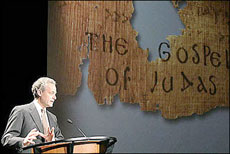WASHINGTON - Lost for almost 1,700 years, a manuscript entitled "Gospel
of Judas" is putting a new spin on the case of the biblical bad guy, maintaining
that Jesus actually asked disciple Judas to betray him.

Terry Garcia,
executive vice president of Mission Programs for the National Geographic,
addresses reporters about the Gospel of Judas at National Geographic
headquarters in Washington, DC. [AFP] |
The third-
or fourth-century ancient Coptic manuscript -- authenticated, translated and
displayed Thursday at National Geographic headquarters here -- paints a
different picture of Judas and Jesus.
The only known surviving copy of the Gospel of Judas, contained in a papyrus
manuscript known as a codex, maintains, as the Bible does not, that Jesus
requested that Judas "betray" him by handing him to authorities for execution,
something it says pained Judas greatly.
National Geographic said the key passage in the Gospel of Judas text comes
when Jesus tells Judas "... you will exceed all of them. For you will sacrifice
the man that clothes me."
The text indicates that Judas, by helping Jesus get rid of his physical
flesh, will help liberate the true spiritual self or divine being within,
National Geographic said in a statement.
"The codex has been authenticated as a genuine work of ancient Christian
apocryphal literature on five fronts: radiocarbon dating, ink analysis,
multispectral imaging, contextual evidence and paleographic evidence," said
Terry Garcia, executive vice president for Mission Programs for the National
Geographic Society.
"This dramatic discovery of an ancient non-biblical text -- considered by
some to be the most significant in the past 60 years -- enhances our knowledge
of the history and theological viewpoints of the early Christian period, and is
worthy of study by historians, scholars and theologians," Garcia said.
The first known reference to a Gospel of Judas is found in a treatise by
Saint Irenaeus, bishop of Lyon, then part of Roman Gaul. The treatise, in around
180 AD, denounces the text as a heresy.
Elaine Pagels, a religion professor at Princeton University and one of the
world's leading authorities on gnostic gospels, said: "The astonishing discovery
of the Gospel of Judas -- along with the Gospel of Thomas, the Gospel of Mary
Magdalene and the many other recently discovered gospels that had remained
hidden for nearly 2,000 years -- is transforming our understanding of early
Christianity.
"These discoveries are exploding the myth of a monolithic religion, and
demonstrating how diverse -- and fascinating -- the early Christian movement
really was."
The 66-page leather-bound papyrus text, believed to have been copied down in
Coptic from an original Greek text around 300 AD, was found in the 1970s in the
desert near El Minya, Egypt. It then moved among antiquities traders from Egypt
to Europe and the United States.
The codex remained in a safe-deposit box in a Long Island, New York bank for
16 years before it was bought by Zurich-based antiquities dealer Frieda
Nussberger-Tchacos in 2000.
Concerned about the rapidly deteriorating condition of the manuscript, she
transferred it to the Maecenas Foundation for Ancient Art in Basel, Switzerland,
in February 2001 for preservation and translation.
Piecing together the fragile 26-page Gospel of Judas, written on both sides
of 13 sheets of papyrus, was "one of the most complex puzzles ever devised by
history," the National Geographic said.
Analysis and translation was conducted by a team of Coptic scholars directed
by Rudolf Kasser, a retired University of Geneva professor, who said he had
never seen a manuscript in worse shape.
The manuscript, now known as Codex Tchacos, will be returned to Egypt and
housed at Cairo's Coptic Museum.